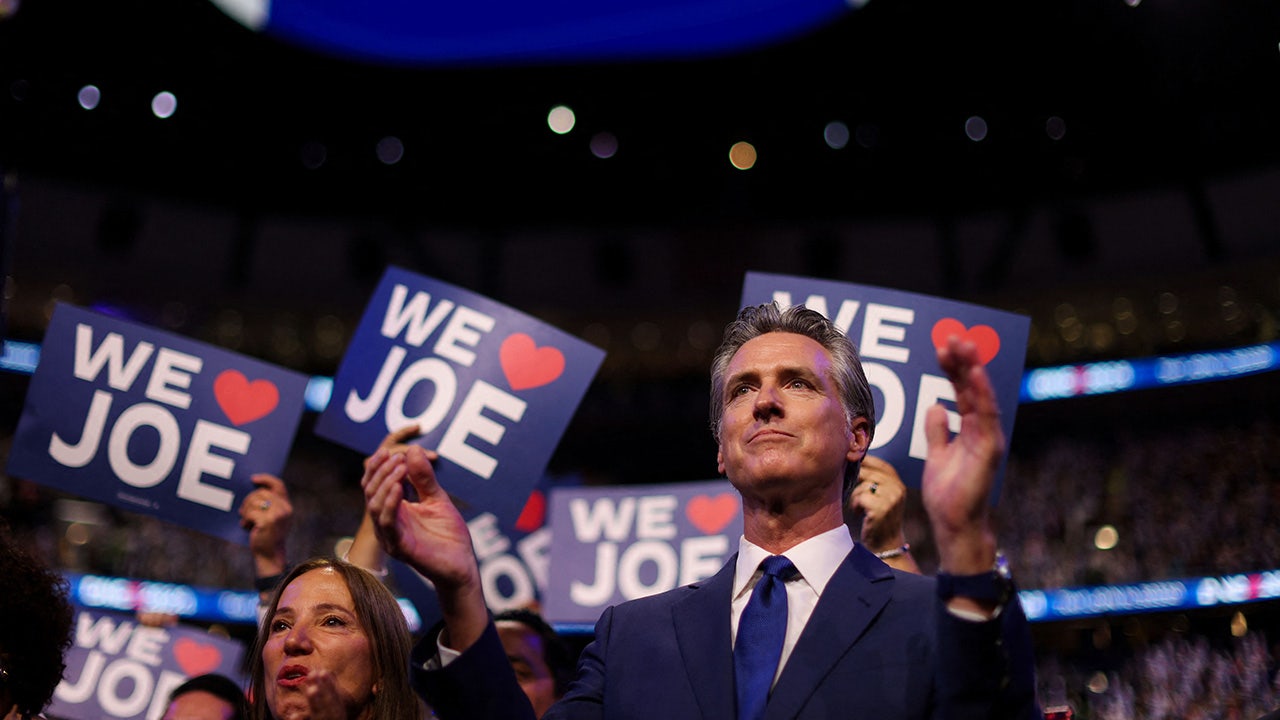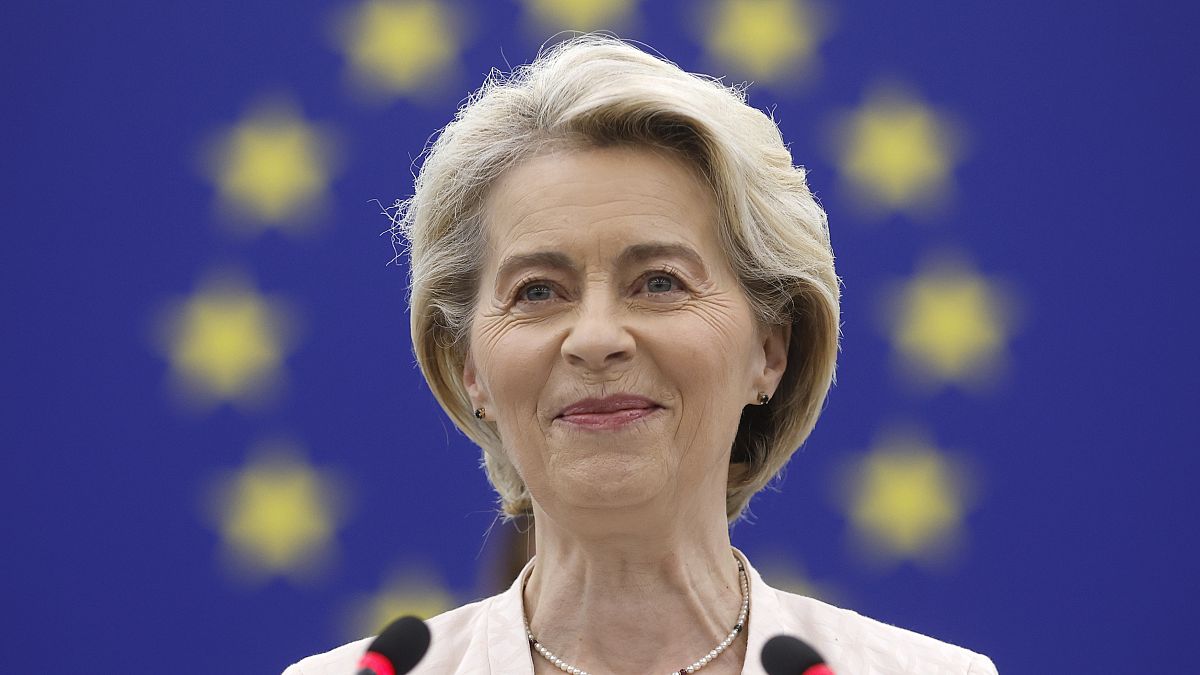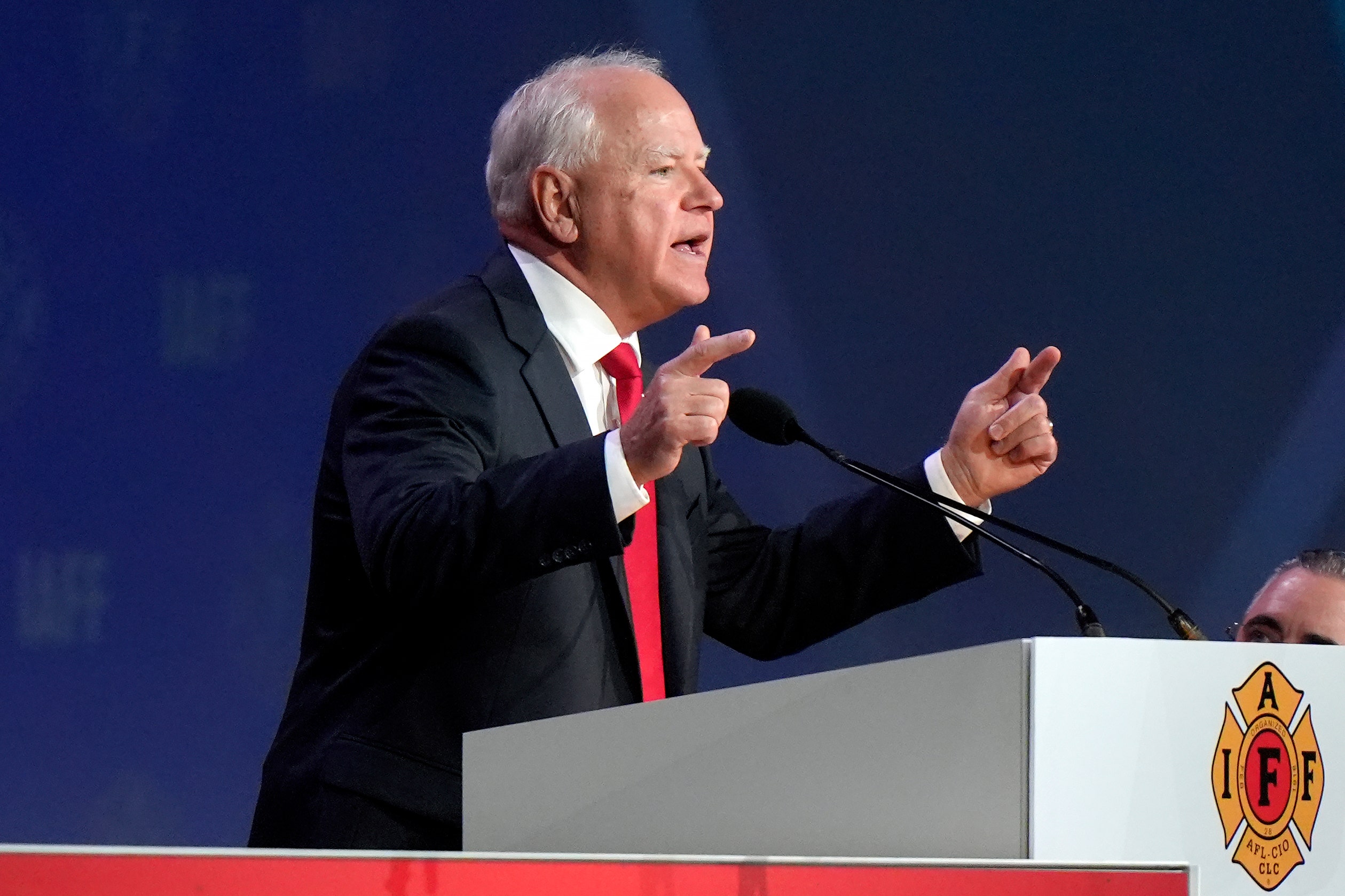Sports
Michigan athletic director says school will 'fight' NCAA on cheating scandal investigations
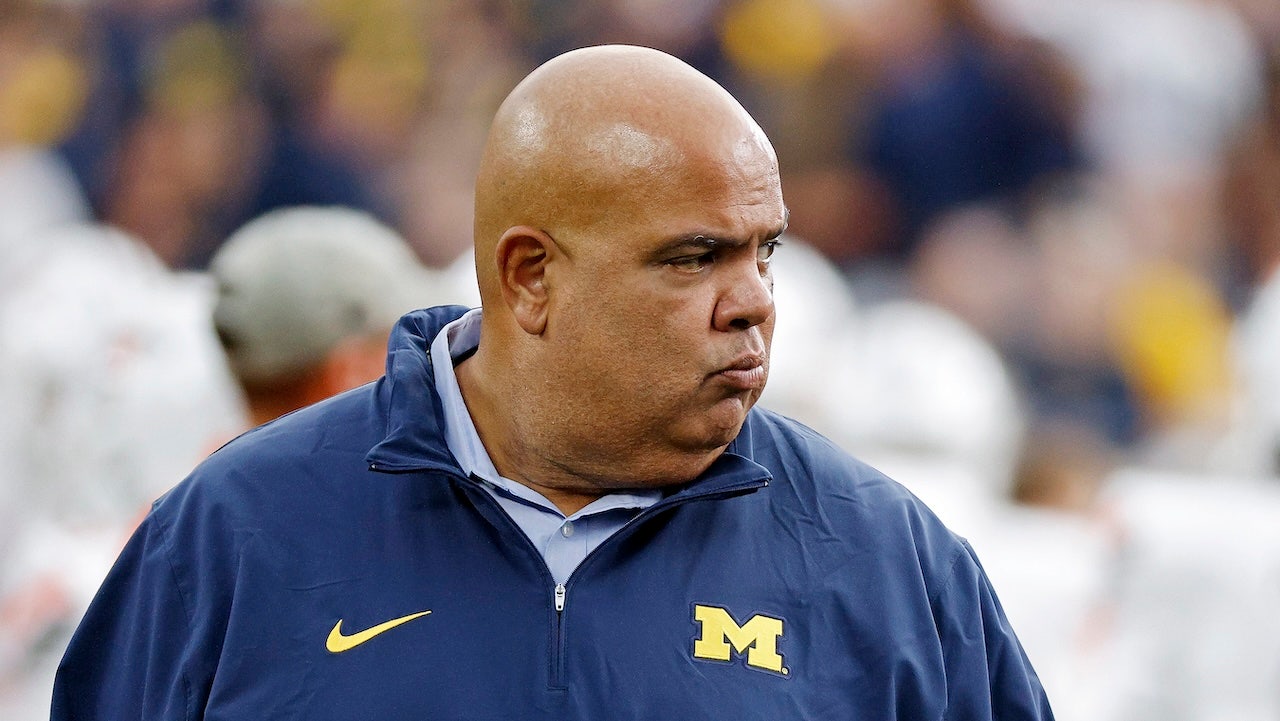
University of Michigan athletic director Warde Manuel’s football program is being investigated for several alleged major violations of NCAA rules.
During an appearance on “The Michigan Insider” this week, Manuel said he and the school will “fight” the NCAA during its investigations.
“First of all, we’re going to fight when we need to fight,” Manuel said. “Also, where we have made mistakes, we’re going to admit them and deal with it. I don’t want people to think because we don’t talk about it publicly — and I can’t — that we’re not going to fight for what we think is right for the University of Michigan and the people that are here. We are.”
Blake Corum (2) of the Michigan Wolverines celebrates with teammates after scoring a touchdown in overtime against the Alabama Crimson Tide during the CFP semifinal Rose Bowl Game at Rose Bowl Stadium Jan. 1, 2024, in Pasadena, Calif. (Kevork Djansezian/Getty Images)
The program is under investigation for alleged illegal sign stealing by former staffer Connor Stalions. The investigation started in the middle of last season and resulted in the suspension of former head coach Jim Harbaugh for the final three regular-season games.
After the team won the national championship against Washington, Harbaugh departed to take over the Los Angeles Chargers, long before the investigations had concluded.
The NCAA recently announced a four-year show cause order for Harbaugh as a result of its investigation into Michigan’s impermissible contact with recruits and players during the COVID-19 pandemic.
Manuel added that his programs are not above the rules.
“But, at the same time, you have to also understand that if we do things that are against the rules, that we know are against the rules, we need to admit it and move forward and deal with it. There’s a duality to that. There’s a sense that you have a responsibility to adhere to rules we say we’re going to participate in, but when it gets to a point where we feel like it is over the top, or we need to fight something, we certainly will,” he said.
ALABAMA STAR JALEN MILROE SAYS MICHIGAN WON ROSE BOWL ‘FAIR AND SQUARE’
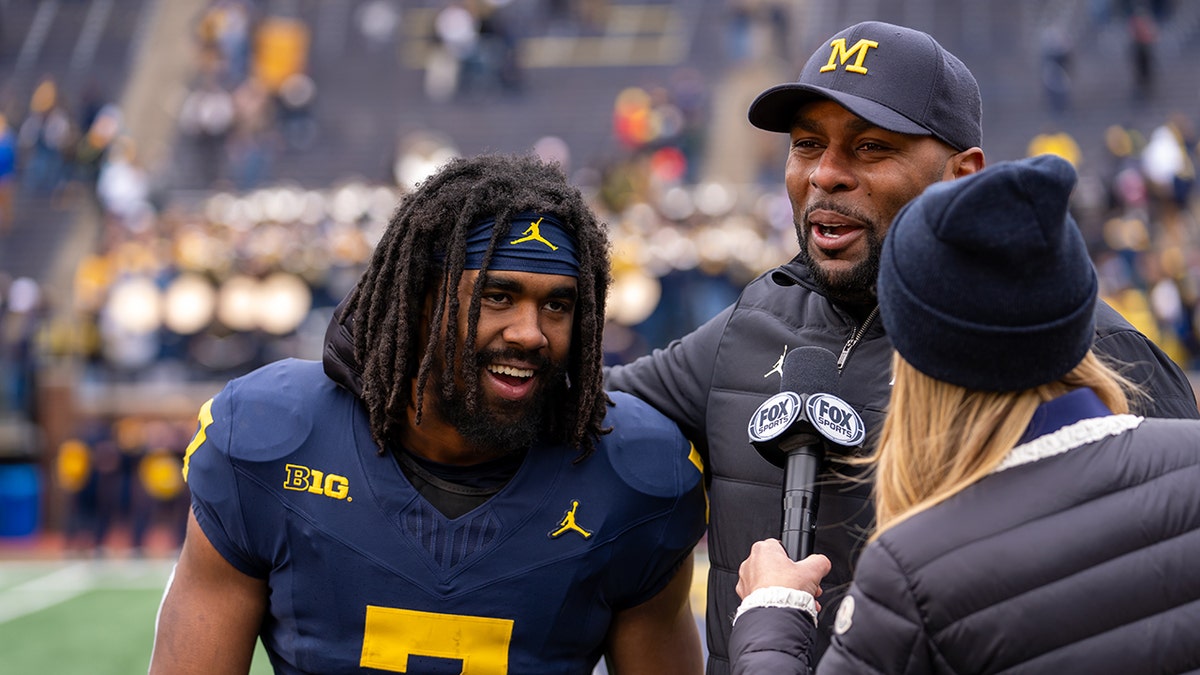
Donovan Edwards (7) of the Blue Team and head coach Sherrone Moore are interviewed after the Michigan spring football game at Michigan Stadium April 20, 2024, in Ann Arbor, Mich. (Jaime Crawford/Getty Images)
Michigan running back Donovan Edwards told Fox News Digital this week the investigations don’t affect his team.
“I personally don’t hear anything. We’re worried about today, not about anything else,” Edwards said. “We’re worried about what goes on in Schembechler Hall and not what other people say and controversy. All we can control is what we can control, and that’s our attitude, effort and what we do on a day-to-day basis.”
Michigan received the final version of a notice of allegations from the NCAA related to the investigation into the alleged violations by Stalions, the NCAA and the school said Sunday. The school now has 90 days to respond. The school could then get a hearing in front of the NCAA’s committee on infractions, though a negotiated resolution is still possible.

Connor Stalions on the the sideline during a game against the Ohio State Buckeyes at Ohio Stadium in Columbus, Ohio, Nov. 26, 2022. (Adam Cairns/Columbus Dispatch/USA Today Network)
Stalions initially was placed on leave by the school and later resigned. He did not participate in the investigation. Stalions is expected to break his silence Tuesday on Netflix when the documentary “Sign Stealer” makes its debut on the streaming service.
Harbaugh has denied any knowledge of the violations.
Meanwhile, head coach Sherrone Moore, who was Harbaugh’s top assistant in 2023 and served as interim head coach during Harbaugh’s multiple suspensions, addressed his alleged relationship with Stalions two weeks ago. Moore has been accused of deleting text messages with Stalions.
“I’ll just say this: I look forward to them being released,” Moore said of his text messages with Stallions.
Follow Fox News Digital’s sports coverage on X, and subscribe to the Fox News Sports Huddle newsletter.

Sports
Naomi Osaka and the gravity of a superstar at the U.S. Open

NEW YORK — On Tuesday afternoon, the world No 88, in the U.S. Open main draw as a wildcard, destroyed the 10th seed Jelena Ostapenko in the U.S. Open first round.
In theory, that sounds like a shock win, but the wildcard in question is Naomi Osaka, a two-time champion here and one of the biggest draws of the tournament.
Osaka may be a natural introvert, but she has the gravity of a superstar, even as a wildcard. From her sensational outfit — which on Tuesday included a customised green tennis dress and a large green bow on her jacket — to her eye-catching power, she had enough to pummel Ostapenko into a 6-3, 6-2 defeat in just over an hour.
Naomi Osaka produced an almost error-free display of tennis to dispatch Jelena Ostapenko (Robert Prange / Getty Images)
Flushing Meadows is most associated with her two greatest triumphs. She won the U.S. Open title here in 2018 and 2020, beating Serena Williams in the first final on a famously tempestuous occasion — through no fault of Osaka’s — to announce herself as a star. But three years ago, it was the site of a breaking point. She threw her racket on multiple occasions and received a code violation for firing a ball into the crowd during an excruciating defeat to Canada’s Leylah Fernandez. When asked about what happened, she said: “I’m not really sure why.”
“Recently, I feel very anxious when things don’t go my way,” she said.
In the three years since, during which Osaka has continued to transcend tennis for her openness to discussing its impact on her mental health, Osaka had not won a match at the Billie Jean King National Tennis Center.
She returned to the sport in late December after giving birth to her daughter, Shai, and upon beating Ostapenko she looked to the sky as tears flowed, overcome by the emotion of her first victory in New York since 2021. There was a lot to process, but what actually set Osaka off went back to her childhood.
“It was a combination of a lot of different things,” she said after her victory.
“I grew up here, so just seeing kids, and then remembering my daughter, but also seeing kids coming and watching me play… And just remembering that I was a kid, I guess a long time ago, made me very emotional,” Osaka said.
Her mind also went back to this time last year when with her daughter not even two months old, Osaka watched on from the stands as Coco Gauff got on her way to winning the title. Osaka didn’t know then whether she could reclaim the level that made her a champion here twice, took her to world No 1, and brought her two more Grand Slam titles, both in Australia.
That feeling has carried on throughout much of 2024, which saw her begin her comeback after 15 months away from the tour on New Year’s Eve. The first half of the season included some promising results, including a barnstorming French Open clash with world No 1 Iga Swiatek, but the last few months have been tough. They have prompted introspection.
After a disappointing loss in the Cincinnati qualifiers to Ashlyn Krueger, Osaka again opened up.
“My biggest issue currently isn’t losses, though, my biggest issue is that I don’t feel like I’m in my body.”

Osaka, laying down on Arthur Ashe after winning the title in 2020, has opened up about her struggles in returning to tennis (Matthew Stockman / Getty Images)
It was a startling admission and perhaps reflected the pressure Osaka was feeling. Throughout the year, the message from those close to her had been that the former world No 1 should be judged not on the promise of the clay and grass swings, in which she found her feet, but during the summer hard-court season.
On her favourite surface, Osaka would come alive.
“It’s almost, like, you have a deadline and you’re crunching at midnight to try to make it,” Osaka said on Tuesday about the narrowing window she has to deliver on hard courts this year. Until Tuesday, her best individual performance had remained that stunning night match at the French Open, where she held a match point against Swiatek. In the two biggest hard-court events ahead of the U.S. Open, Osaka lost in the second round at the Canadian Open and then failed to qualify for Cincinnati.
Even giving herself the grace of returning to the tour after giving birth, Osaka was impatient and concerned. She likened her discomfort on court to how she had felt in general postpartum. Desperate to feel herself again in competition, on Tuesday that feeling returned.
The Louis Armstrong Stadium fizzed with anticipation after Osaka’s two-year absence. A striking matchup against Ostapenko, a top-10 player who can come alive on the biggest occasions — and has an unbeaten record against Swiatek — only added to the feeling that this match, like Osaka and Swiatek’s second-round encounter in Paris, would befit a late-stage occasion rather than an opener. Osaka, world No 88 or not, retains the gravity of all she has done in the sport no matter her ranking.
The match started evenly, but from the moment Osaka broke at 4-3 in the first set, the outcome was never in doubt. She started to hit her forehand with increasing freedom and venom; Ostapenko, a former French Open champion, had no answer.

GO DEEPER
How should a world No 1 be? Iga Swiatek and Naomi Osaka have an idea
Osaka celebrated points with loud “come ons” and fist pumps and the crowd matched her noise and energy. In what was an outstanding exhibition of controlled aggression, she didn’t lose her serve throughout and banged down nine aces to secure a first win over a top-10 opponent for more than four years. After Osaka had clinched the victory with a cross-court forehand winner, she sat down and covered her face with a towel as the tears poured out.
“Just seeing the stadium really full, it meant a lot because I was, like, ‘Oh, I hope people come watch me play,’” she said afterwards.
She followed up that piece of disarming modesty by laying down the gauntlet in the most softly spoken and understated way imaginable.
“I feel like for me, this court is my home — it gives me so much more confidence.”
She also had extra motivation to beat Ostapenko on Tuesday, knowing that if she did, she would get the chance to wear the other outfit she had ready for the tournament. “That was very important to me,” Osaka said with a smile.
Where this run will lead is in question. Osaka next faces last year’s semifinalist Karolina Muchova of the Czech Republic, with another opportunity for a statement victory. Before all of that, she can soak in a win against a top-tier opponent and the U.S. Open can once again revel in the gravitational pull of a tennis superstar.
(Top photo: Robert Prange/Getty Images)
Sports
Can Troy Reeder pick up slack in middle of Rams defense after Ernest Jones IV trade?
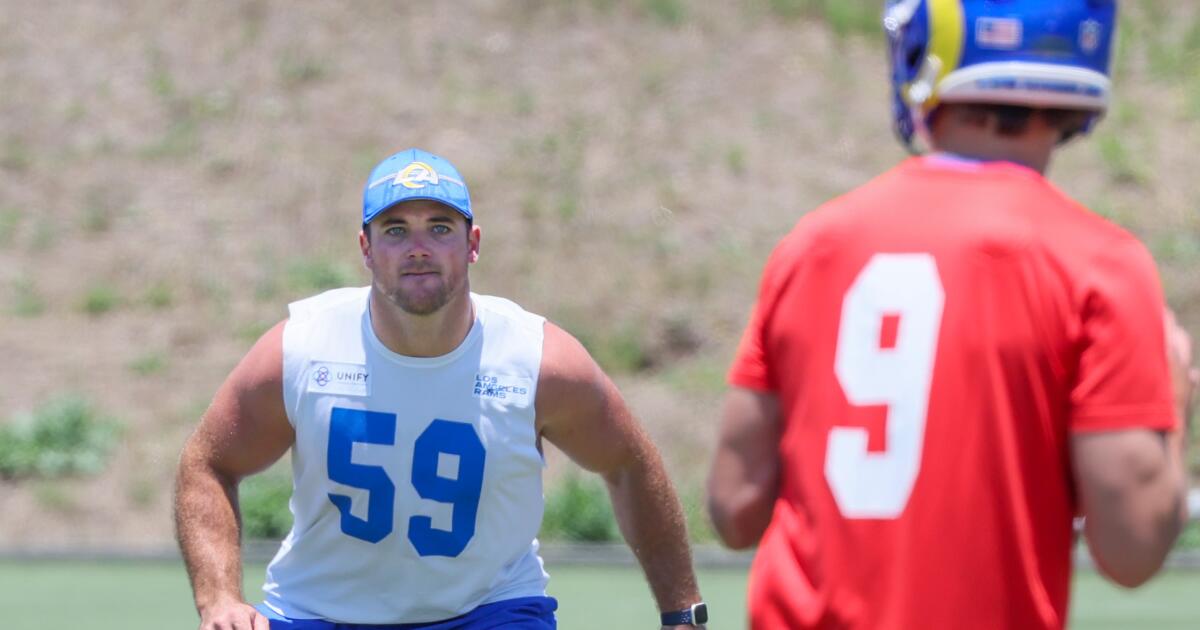
Troy Reeder left the Rams’ facility, returned home to see his wife and son and enjoyed dinner with the family.
It was a “nice normal” evening, Reeder said Wednesday.
Much had changed for the Rams and Reeder before that Tuesday night meal.
Hours earlier, the Rams traded starting inside linebacker Ernest Jones IV — a team captain and the team’s leading tackler in 2023 — to the Tennessee Titans.
Coach Sean McVay, defensive coordinator Chris Shula and Rams players now would look to Reeder, a sixth-year pro, to start and possibly take on the role of defensive signal caller.
“It just felt like, because of how they train you here, that you’re ready for whatever opportunity you get,” Reeder said.
Reeder, who played at Penn State and Delaware, has made the most of his time in two stints with the Rams.
After signing as an undrafted free agent in 2019, he played mainly on special teams and as a rotational player. In 2021, Reeder started 10 games and made 91 tackles. He also started three playoff games before playing 21 defensive snaps and 24 special teams snaps in the Rams’ Super Bowl LVI victory over the Cincinnati Bengals at SoFi Stadium.
Reeder played for the Chargers in 2022, and then spent time with the Minnesota Vikings in 2023 before rejoining the Rams on a veteran-minimum contract.
Reeder said his time with the Chargers and Vikings felt like he “studied abroad.” He was happy to return to the Rams and “the place that raised me,” he said.
The Rams are counting on linebacker Troy Reeder being able to solidify the middle of the defense.
(Scot Tucker / Associated Press)
“I felt like it was a great opportunity to restart here — with a whole new perspective on things,” he said.
After starting last season on the practice squad, he worked his way into the lineup and started six of the last nine games for a Rams team that finished 10-7 and advanced to the playoffs.
Reeder’s approach has remained the same.
“Every camp I come in, there’s really no guarantees for anything — whether you’re a starter, back-up, punt guard or on the team,” he said. “Just approach every day like it’s an opportunity to get better. A little better every single day.”
Reeder said he learned much about leadership and on-field skills from watching, sharing information with and playing alongside Jones.
Shula said he appreciated Jones’ contributions during the linebacker’s three seasons with the Rams.
Now he will depend on Reeder, Christian Rozeboom, Jacob Hummel and rookies Omar Speights and Elias Neal, all of whom were undrafted free agents.
Shula expressed confidence in Reeder.
“Just a consistent guy,” Shula said, “No matter what — consistent demeanor. … It’s like having a coach on the field.”
If McVay and Shula entrust him with signal-calling responsibilities, Reeder said he would be prepared.
Helping the Rams return to the Super Bowl is his goal.
“Winning a Super Bowl in any capacity you play is the most fun I’ve ever had in a sports season and, honestly, one of the highlights of my entire life,” he said. “So, ultimately, like now in my sixth year, that’s kind of all I think about is getting back to that point.”
Etc.
The Rams signed defensive lineman Neville Gallimore, who was cut Tuesday by the Miami Dolphins. Gallimore, 27, was a third-round draft pick by the Dallas Cowboys in 2020. He played in 17 games last season and made 16 tackles, including a sack. … The Rams claimed running back Cody Schrader off waivers from the San Francisco 49ers. During the preseason, the former Missouri standout rushed for 48 yards on 19 carries, caught two passes and averaged 30.0 yards on four kickoff returns. To make room for Gallimore and Schrader, the Rams waived defensive lineman Cory Durden and put offensive lineman Conor McDermott on injured reserve. … After missing the Mondayworkout because of what McVay described as a family matter, quarterback Stetson Bennett returned to practice. Quarterback Jimmy Garoppolo and left tackle Alaric Jackson, who were suspended by the NFL for the first two games, are not eligible to participate in team activities until Week 3. … McVay said starting running back Kyren Williams will be the Rams’ punt returner, at least for now. “It’s another opportunity for him to get touches and impact the game,” McVay said
Sports
Explained: The Champions League draw, the Swiss Model and how selection is going digital

The Champions League proper returns next month and this season it will have a brand new format.
The ‘Swiss Model’ makes its debut and, as a result, the Champions League draw tomorrow (Thursday) is going to look rather different to the eight-groups-of-four setup we’ve all become used to in recent years.
So let The Athletic take you through everything you need to know about the draw and the new look for UEFA’s flagship club competition.
First, a quick recap. What is the Swiss Model and why are there so many teams now?
The new format has a ‘league phase’ rather than a ‘group phase’. It ditches eight groups of four and crams all the competing clubs together in one massive table. The format is based on the Swiss system used in chess, and does not require every team to play all of the others.
The number of teams participating increases by four, to 36, with each participant now playing eight matches in the first phase, instead of six in previous iterations. But instead of just three different opponents twice, home and away, teams will face a different team in every game.
In total, there will be 189 matches in the competition proper, capped by the final in Munich on May 31, up from the previous 125.
UEFA hopes the new format will lead to more competitive fixtures from the off, with bigger games earlier in the tournament because teams from pot one (aka, the big names) will play each other earlier rather than largely being kept apart until the knockout phase in February and March, as happened with the previous format. It will also give teams in pot four more of an opportunity to pick up points, because they will be playing two other sides from that pot among their eight matches.
Once the league phase has been completed, which will now take until late January, the top eight sides in the table will qualify directly for a 16-team knockout round, with the other eight places decided by a newly introduced set of two-leg play-offs contested by the teams who finish between ninth and 24th in the league.
The round of 16 and beyond will now be seeded, so the teams who finish first and second in the league phase cannot face each other until the final.
This season’s lineup will be completed tonight, with four clubs winning their places via the last of seven pre-tournament play-offs.
So how does this change the draw format?
Unlike previous years, where teams were drawn into eight groups from four pots, there will be four pots of nine this year, and they will all be seeded by coefficient. A club’s UEFA coefficient is a score based on the results of teams competing in the five previous seasons of the Champions League, Europa League and Conference League.
There’s one exception to that: the only club who won’t be seeded by coefficient are the Champions League title holders, in this case Real Madrid. They will be the first side drawn.
(Robert Michael/picture alliance via Getty Images)
Also, whereas last time every team was manually drawn, and there would be another manual draw to decide which group they would be put in, the draw will now be almost entirely automated.
All 36 teams will be manually drawn by someone on stage. But when a team come out of the ‘hat’, a button will be pressed and, hey presto, their eight opponents will appear. It will also say whether the team has been drawn to play at home or away (they’ll have four of each).
Each team will face two opponents from each pot, including two from the same one they are in.
This will be repeated until all 36 teams have been drawn. Every team will be drawn once but, as the process moves along, fewer sides will need to be assigned fixtures.
So can teams from the same nation face each other in the first phase now?
No. Or not this season, at least. It is no longer entirely impossible, in theory anyway. But the aim is to ensure that does not happen.
The new automated software will have to follow two UEFA rules. The first is that no club will face another from the same nation — unless there is the possibility of what is called a ‘deadlock’ situation; in other words, if it is impossible to avoid putting those teams together without stopping the draw. This is more likely to happen if one nation had a lot of clubs in the same pot, for example. But there is no risk of that for 2024-25.
The other rule is that it will only be possible to face a maximum of two teams from another association. So you won’t see Manchester City taking on all four Spanish qualifiers.

Manchester City’s group in last season’s draw (Valerio Pennicino – UEFA/UEFA via Getty Images)
Why has UEFA gone digital?
The main reason is to save time.
UEFA says that, if the entire draw was to be completed manually, around 1,000 balls would be spread across at least 36 bowls on stage and the whole process would take more than three hours.
Even digitally, drawing pot one is still expected to take 17 minutes.
“Based on rehearsals we have done, we are expecting some 35 minutes of a draw, which is exactly what he had before,” says Tobias Hedtstuck, UEFA’s head of club competitions and calendar, speaking at the body’s briefing on the new system for the media earlier this month.
That time does not factor in the draw’s presentation and sideshow events.
No changes there yet. Sorry about that.
Who is responsible for the software?
Now for the key question. Who has been crafting this mysterious technology?
UEFA has been working on this draw process for nearly a year. The software will be provided by AE Live, which was appointed as UEFA’s partner for all UEFA draws in September 2023 and tasked with developing and testing the software.
And what, you might ask, is AE Live? Well, it’s a company that works in live sport and provides graphic and technology solutions for the industry and has offices in eight countries.
“When it comes to our experience, we have our in-house teams which have a wealth of experience delivering live services across a range of sports, such as cricket, rugby, badminton and even kabaddi,” says Dave Gill, AE Live’s chief technology officer. “But we do have a particular strength in football, across both international and domestic competitions.”
AE Live has provided draw services for more than 20 years, including for the FA Cup, to FIFA, as well as for the International Olympic Committee and CAF, African football’s governing body. “We are very well qualified to provide this draw solution and to support UEFA in this exciting new development,” Gill says.
Global financial services company Ernst and Young has also been appointed to give an “extra layer of assurance and transparency”, according to Giorgio Marchetti, UEFA’s director of football and deputy general secretary. Ernst and Young have audited and monitored the development of the software, and its personnel will also observe and report on the draw operations itself.

Former England midfielder Joe Cole assists with the Champions League’s final manual draw last season (Claudio Lavenia – UEFA/UEFA via Getty Images)
And what happens if this software crashes?
There are fail-safes in place should issues arise, and also to ensure the draw remains feasible and there is no ‘deadlock’ scenario. That means the software has to ensure it’s still possible to find opponents for everyone else after a team is drawn. It assesses this itself when drawing opponents for a given club.
There are also two independent external checking systems.
“The role of these checking systems is to simply confirm what has already been established: that the rules of the draw have been followed and the draw remains feasible,” said Gordon Vince, chief software architect. “This checking takes no more than a second. As a result of that, we have extra confidence that the rules are being followed and that the draw remains feasible.
“Only then are the teams ready to be revealed.”
What about cyber-attacks?
AE Live says it is taking the risk of a cyber-attack seriously and has put several protections in place to keep the draw secure.
“The draw itself will be conducted in an entirely closed environment,” Gill says. “There will be no external access from external interference for a period of time before the draw and during the draw, so there’s no DDoS (distributed denial-of-service) attack (which can overwhelm the system and cause it to fail).
“Access to our code, and our code repository, are controlled through multi-factor identification. It’s a very limited amount of people who have access to our code. We’ve just conducted some penetration testing from an external third-party provider to make sure that we are, as a business, as secure as we can be. We’ve done additional risk assessments around the increased risk around cyber-attacks.”
Surely this fancy computer will be biased against (insert your club here)?
UEFA is also trying to ensure everyone feels comfortable with a process that is not visible, which could easily lead to conspiracy chatter.
“That’s why we appointed an external company (Ernst and Young),” says Marchetti, “to confirm not only that the software has been properly set up, and is purely random while respecting the couple of rules that we have, but also to observe the implementation and application of the software, as well as the procedures on the day of the draw.”
Ernst and Young staff will produce a report after the draw. In a statement, the company said: “In our opinion, in all material aspects, the software source code of AE Live selects and allocates football teams randomly and correctly, in accordance with the league-phase digital draw procedure defined by UEFA.”

Real Madrid’s Dani Carvajal brings out the Champions League trophy before the UEFA Super Cup win over Atalanta (Mikoaj Barbanell/SOPA Images/LightRocket via Getty Images)
What are the worst- and best-case scenarios for each club?
The final lineup for the draw won’t be confirmed until after those final four play-off second legs tonight, so only then will we know the final pot positions and risks for each of the 36 teams.
But we do have an idea about how likely it is that a club faces the hardest possible opponents (ie, the top two sides from each pot) and vice versa.
UEFA has estimated that the probability of either happening is 0.00006 per cent. UEFA says that in the previous iteration of the group stage, that probability was 0.2 per cent.
Doing it this way should make the league phase more competitive.
When will we find out the actual fixtures?
This is a key detail for those looking to book flights and hotels as early as possible.
The dates for the fixtures are not going to be released on the same day as the draw.
That information will be announced at some point on Saturday, August 31, in order to ensure the logistical and security dilemmas of the Europa League and Conference League, UEFA’s second- and third-tier club competitions can be taken into account, too.
“The opponents are selected pot after pot, but the order in which they are displayed does not mean the order of the (match) calendar,” says Marchetti. “The calendar will be decided based on different software; based on hundreds, if not thousands of constraints that we have, such as clubs who play in the same cities, or even the same stadium.”
Each team will play one game at home and one away against sides in each pot. UEFA is aiming to have a “fair and balanced split” between Tuesday and Wednesday matches as well, but this is not guaranteed.
UEFA also wants to spread out the competition’s “top matches”, for spectacle and sporting reasons.
“The key target is that in matchday one and two, or seven and eight, you (a club) should not play two pot-one teams in a row,” says Hedtstuck. “They should spread a little bit. We will try this for all 36 teams. The new system should have a more balanced calendar. Security constraints will have to be prioritised.”
How can we follow it?
The draw will be streamed live for free on UEFA’s website as well as broadcast on their broadcasting partner networks. Those will include TNT Sports in the UK and Paramount in the United States.
When and where is the draw?
The most important detail is saved until last.
The draw is to be held at the Grimaldi Forum, an exhibition centre in Monaco, on the south coast of France, and will be conducted at 5pm BST/12pm ET tomorrow (Thursday, August 29).
The Europa League and Conference League draws, both following the same 36-team format, happen there the following day at 12pm BST/7am ET and 1.30pm BST/8.30am ET respectively.
(Top photo: Rob Newell – CameraSport via Getty Images)
-
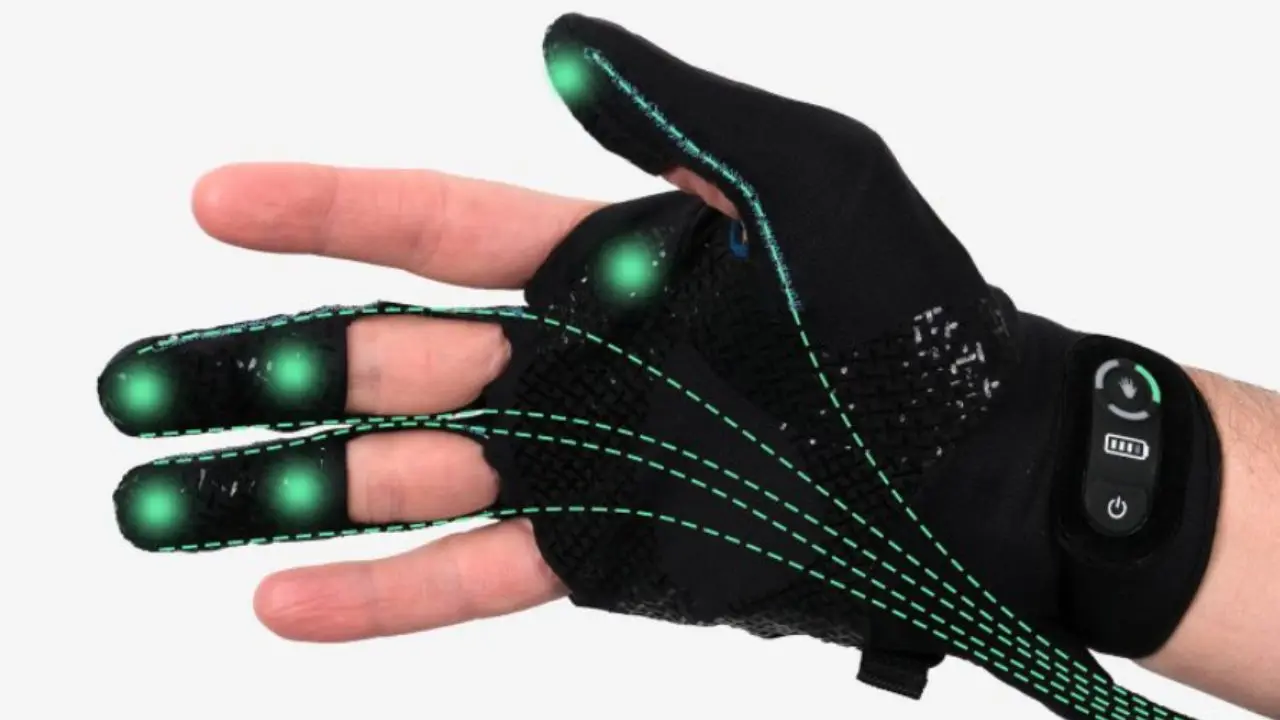
 Technology7 days ago
Technology7 days agoBreakthrough robo-glove gives you superhuman grip
-

 Connecticut5 days ago
Connecticut5 days agoOxford church provides sanctuary during Sunday's damaging storm
-

 News1 week ago
News1 week agoVideo: Biden Delivers Keynote on First Night of D.N.C.
-

 News1 week ago
News1 week agoVideo: Protesters Clash With Police Near the Democratic National Convention
-
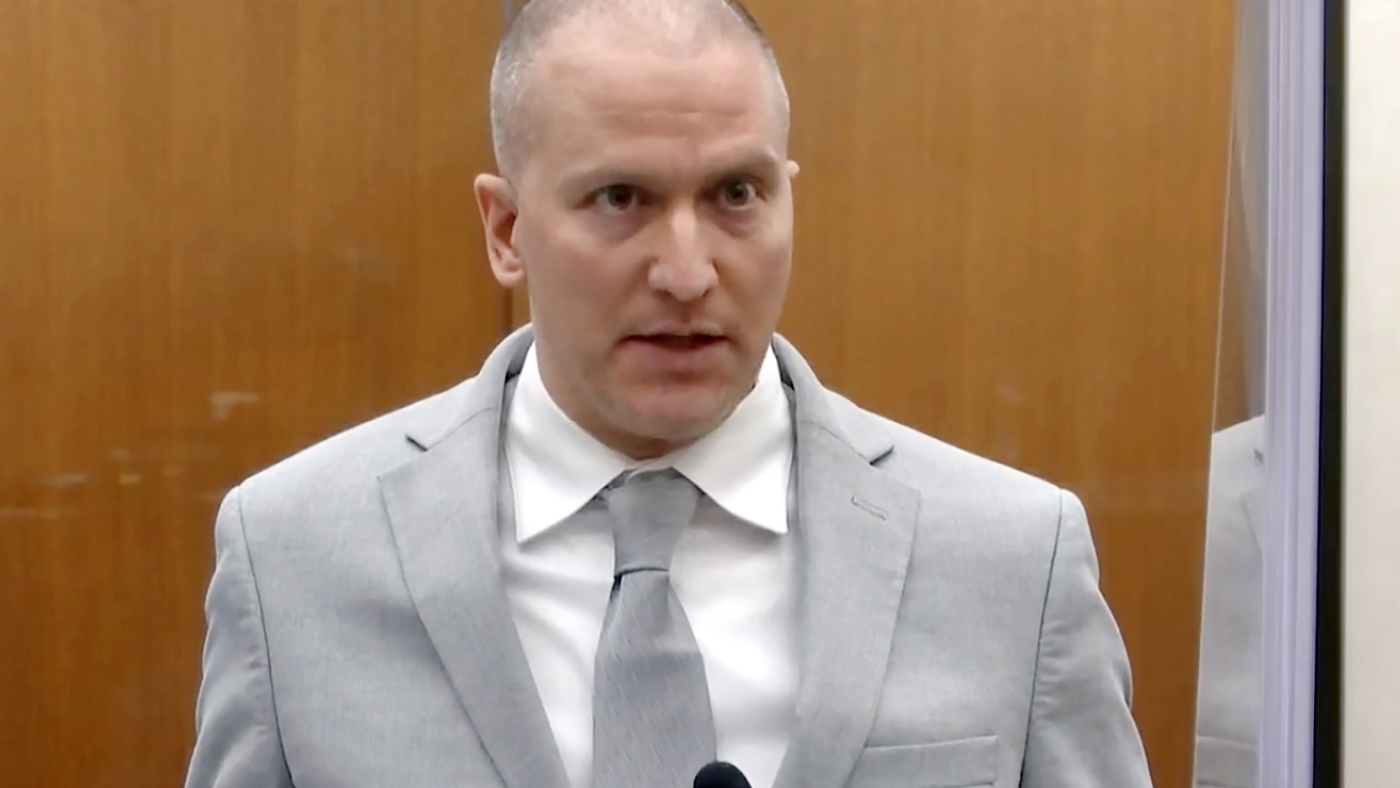
 News1 week ago
News1 week agoEx-officer convicted in George Floyd's killing is moved to new prison
-
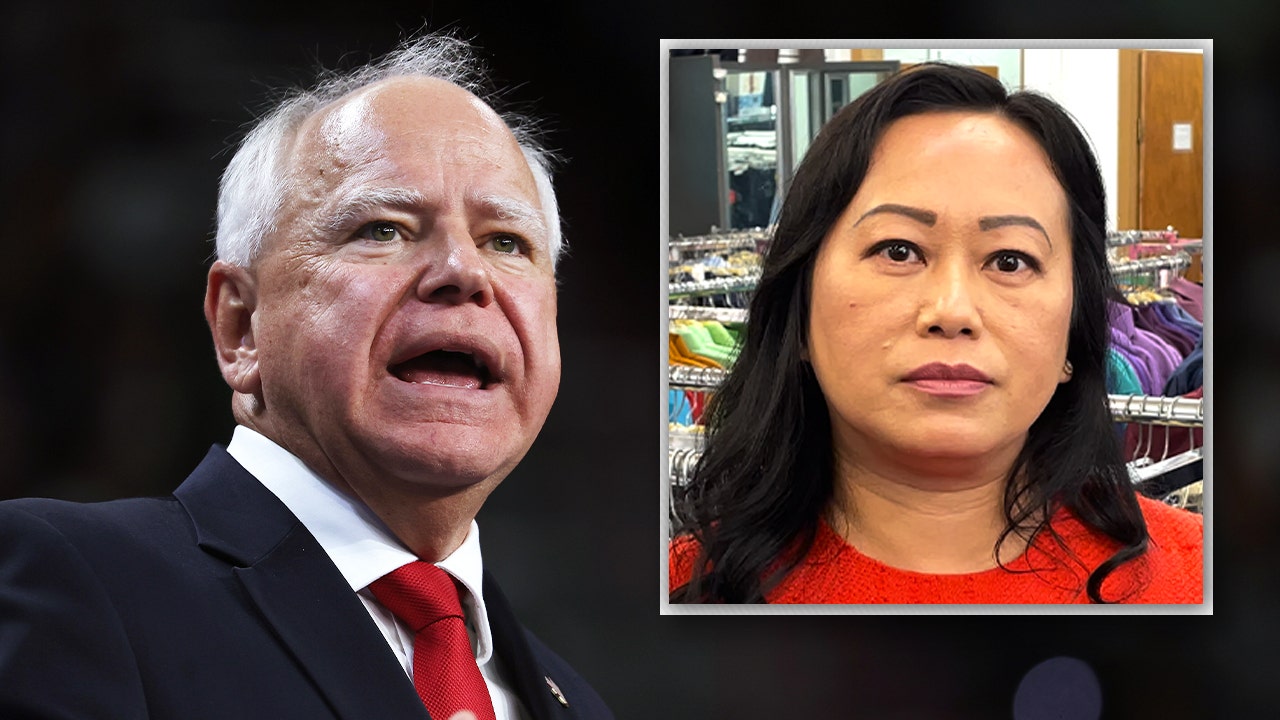
 Politics1 week ago
Politics1 week agoFormer teacher reveals which students suffered 'the most' under Walz's pandemic-era guidelines
-

 News1 week ago
News1 week agoVideo: D.N.C. Holds Enthusiastic Roll Call to Nominate Harris
-

 World1 week ago
World1 week agoPanama deports 29 Colombian migrants from Darien Gap under US deal











